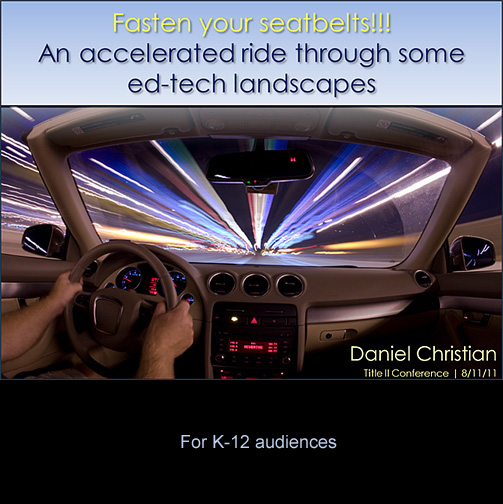Head in the clouds? Ten free Web 2.0 tools to support faculty research — from FacultyFocus.com by G. Andrew Page, Ph.D.
Our Top 11 Most Popular Articles for 2011, part 1 — from Faculty Focus
As another year draws to a close, the editorial team at Faculty Focus looks back on some of the top articles of the past year. Throughout 2011, we published nearly 250 articles. The articles covered a wide range of topics – from academic integrity to online course design. In a two-part series, which will run today and Wednesday, we reveal the top 11 articles for 2011
Our Top 11 Most Popular Articles for 2011, part 2 — from Faculty Focus
It wouldn’t be the end of the year without a few top 10 lists, but this year we’re taking it one step further with the top 11 articles of 2011. Each article’s popularity ranking is based on a combination reader engagement metrics. Today’s post reveals the top five most popular articles.
Making the Review of Assigned Reading Meaningful — from Faculty Focus
The typical college student dreads hearing, “Let’s review the chapters you read for homework.” What generally ensues is a question and answer drill in which students are peppered with questions designed to make clear who has and hasn’t done the reading. In reality, these exchanges do little to encourage deep thought or understanding of the assigned reading. Here are some new ways to approach the review of reading assignments.
Also see:
- Academia.edu raises $4.5 Million for Researcher Social Network — from edukwest.com by Kay Alexander
Best practices help dispel the myths of online faculty hiring practices — from Faculty Focus by Mary Bart
Excerpt:
Some of the myths include:
- Faculty who only teach online courses are typically hired “differently” than faculty who teaching face-to-face.
- Academic departments are reluctant to use geographically-dispersed faculty to teach online courses.
- Little to no effort is made to integrate faculty who teach only online courses into a department’s faculty community.
- Faculty who teach only online courses are not subject to the same kind of teaching evaluation as those who teach face-to-face courses.
10 telling employment trends in academia — from bestcollegesonline.com; also saw this at the ASTD.org site
Excerpt:
The job outlook for university professors is a bundle of contradictions, confusing — and threatening — even the most prestigious of teachers. While a generation of professors is retiring and leaving new job openings, the economy is still crumbling, and slashed state budgets and diminished endowments make it difficult for schools to pay competitive salaries, or keep full-time professors on staff. Part-time and online positions are increasing, however, and professors now need to be even savvier about how they track their careers, just like professionals in other fields. Here are 10 telling employment trends for academics.
Be nice to techies — from Steve Wheeler, Associate Professor of learning technology in the Faculty of Education at the University of Plymouth
From DSC:
A hearty “Amen!” to this Steve! 🙂
Should you write an ebook? — from forbes.com by Nick Morgan
Excerpt:
Here are some of the current e-options that have sprung up around traditional publishing and self-publishing.
Lecture Capture: Lights! Camera! Action! — from CampusTechnology.com by John Waters
A solid article that includes the following list of lecture capture vendors (along with this excerpt):
Lecture capture isn’t a new concept. College and university professors have been videotaping their courses for about 25 years. But in the past 10 years–thanks to the advent of warp-speed processors, broadband connectivity, and cloud-based data storage–the technology for recording and publishing class lectures has evolved dramatically. The current lineup of lecture capture solutions includes products that rely on proprietary hardware, specialized software platforms, web-based systems, and combinations of all three. Profiled below are a few of the principal vendors.
Separate and unequal — from InsideHigherEd.com by Dan Berrett
NEW YORK — Higher education’s own hiring practices are undermining one of its chief selling points: that a college education fosters upward mobility, several speakers said here Tuesday at a conference on academic labor.
In particular, it is the condition of adjunct faculty members, which was the subject of several sessions of the annual meeting of the National Center for Collective Bargaining in Higher Education and the Professions, that casts the harshest light on the gap between academe’s aspirations and its actual conduct.
“In order to maintain faith with higher education, you have to be able to confront the idea that a high proportion of the most educated portion of the population is having trouble making ends meet,” said Alan Trevithick, founding member of the New Faculty Majority and an adjunct who teaches sociology at Fordham University and Westchester Community College, during a session entitled “Contingent Faculty: Issues at the Table.”
…
“The non-tenure-track faculty make the tenure-track research positions possible,” said Robert Samuels, a lecturer in the writing programs at the University of California at Los Angeles and president of the University Council, American Federation of Teachers. The adjunct faculty serve this enabling purpose in two ways, said Samuels: they assume much — and in many cases, the majority — of the teaching load, thus freeing up time for full-time faculty to do research; and their lesser salaries for teaching highly enrolled undergraduate courses also result in net revenues that essentially subsidize other, more costly work at the university.
From DSC:
It will be interesting to see how the developing online-based exchanges/marketplaces affect the professional adjunct faculty member — who may already be teaching at a variety of institutions at the same time. My guess would be that they will be well positioned to move into this developing new landscape — if this landscape continues to develop in that manner.




















